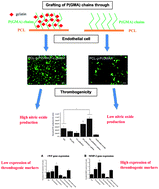Endothelial cell thrombogenicity is reduced by ATRP-mediated grafting of gelatin onto PCL surfaces†
Abstract
Reducing the thrombogenicity of a tissue-engineered vascular graft prior to implantation is important for improving graft patency. As functionalization of synthetic materials with cell-adhesive proteins is routinely utilized as a means to promote endothelial cell (EC) growth, we conducted detailed investigation on the proliferation and thrombogenicity of ECs on such functionalized surfaces. We observed that polycaprolactone (PCL) surfaces functionalized with poly(glycidyl methacrylate) [(P(GMA)] brushes via atom transfer radical polymerization (ATRP) alone resulted in the enhancement of an activated EC profile characterized by low production of nitric oxide (NO), platelet activation and elevated expression levels of von Willebrand factor (vWF) and matrix metalloproteinase-2 (MMP-2). When gelatin was conjugated onto the PCL-g-P(GMA) surfaces, not only were EC proliferation and endothelial coverage significantly improved, but an anti-thrombogenic profile was also observed. We demonstrated that PCL can be successfully functionalized by a controllable surface-initiated polymerization method and importantly, the thrombogenic profile of the endothelial cells can be influenced by material surface chemistry (e.g. the presence of polymer graft chains). Our findings emphasize the importance of a careful consideration of materials for vascular graft applications, as well as differential endothelial cell physiology on surfaces with different material chemistry.


 Please wait while we load your content...
Please wait while we load your content...